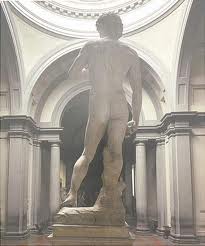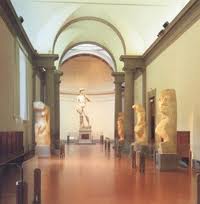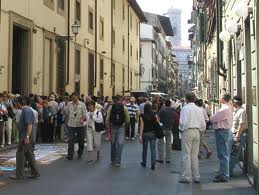The Accademia and Uffizi are the two most popular museums in Florence – the latter holds one of the largest art collections in the world and the former apart from being a very important gallery is home to Michelangelo’s David – probably the most famous statue ever.
The accademia is about 12 minutes walk away from Deimori – probably the longest walk you are likely to have to take.
The opening hours are as follows:
Tuesday to Sunday (Closed Monday) 08:15 to 18:50
During the summer the gallery is often open until 21:30 – a great time to go, no lines.
We at DeiMori Bed and Breakfast and La Massa Guest Accommodation in Tuscany always suggest that you aim to arrive at the Museums well before 10:00 which is the time the bus tour groups arrive – it is always a great idea to avoid the herds. An 08:00 start is the best plan.
The entrance fee is €6.50 and this is subject to a €4 booking fee when an appointment time is booked in advance.
There are concessions in that young people under 18 years and senior citizens over 65 (Both groups from European Community Member States (EEC) have free entry. Evidence of age and European Citizenship has to be given.
During the tourist ‘season’ effectively mid March to mid November, one is strongly advised to reserve as queues can be several hours long. If you do not wish to pre-book, it is almost essential to be there before 08:00 or nearer to closing time in the afternoon.
We can make a reservation for you, just give us maximum notice and some flexibility. We will give you a reservation number. It is essential that you bring this with you as we do not always keep a record.
If you decide to reserve yourself (there is an English option) call +39 055 294 883
There is a short biography of Michelangelo to follow:
Michaelangelo 1475 – 1564 – Michelangelo was one of the most inspired creators in the history of art and, with Leonardo da Vinci, the most potent force in the Italian High Renaissance. As a sculptor, architect, painter, and poet, he exerted a tremendous influence on his contemporaries and on subsequent Western art in general. A Florentine-although born March 6, 1475, in the small village of Caprese near Arezzo-Michelangelo continued to have a deep attachment to his city, its art, and its culture throughout his long life.
Early Life in Florence Michelangelo’s father, a Florentine official named Ludovico Buonarrotiwith connections to the ruling Medici family, placed his 13-year-old son in the workshop of the painter Domenico Ghirlandaio. After about two years, Michelangelo studied at the sculpture school in the Medici gardens and shortly thereafter was invited into the household of Lorenzo de’ Medici, the Magnificent. There he had an opportunity to converse with the younger Medici, two of whom later became
The high point of Michelangelo’s early style is the gigantic (4.34 m/14.24 ft) marble David (Accademia, Florence), which he produced between 1501 and 1504, after returning to Florence. The Old Testament hero is depicted by Michelangelo as a lithe nude youth, muscular and alert, looking off into the distance as if sizing up the enemy Goliath, whom he has not yet encountered. The fiery intensity of David’s facial expression is termed terribilita, a feature characteristic of many of Michelangelo’s figures and of his own personality.
David, Michelangelo’s most famous sculpture, became the symbol of Florence and originally was placed in the Piazza della Signoria in front of the Palazzo Vecchio, the Florentine town hall. With this statue Michelangelo proved to his contemporaries that he not only surpassed all modern artists, but also the Greeks and Romans, by infusing formal beauty with powerful expressiveness and meaning.
Michelangelo created a series of nude and clothed figures in a wide variety of poses and positions that are a prelude to his next major project, the ceiling of the Sistine Chapel in the Vatican. The Sistine Chapel Ceiling Michelangelo was recalled to Rome by Pope Julius II in 1505 for two commissions. The most important one was for the frescoes of the Sistine Chapel ceiling.
Working high above the chapel floor, lying on his back on scaffolding, Michelangelo painted, between 1508 and 1512, some of the finest pictorial images of all time. On the vault of the papal chapel, he devised an intricate system of decoration that included nine scenes from the Book of Genesis, beginning with God Separating Light from Darkness and including the Creation of Adam, the Creation of Eve, the Temptation and Fall of Adam and Eve, and the Flood.
Michelangelo painted his own image in the flayed skin of St. Bartholomew. Although he was also given another painting commission, the decoration of the Pauline Chapel in the 1540s, his main energies were directed toward architecture during this phase of his life.
During his long lifetime, Michelangelo was an intimate of princes and popes, from Lorenzo de’ Medici to Leo X, Clement VIII, and Pius III, as well as cardinals, painters, and poets. Neither easy to get along with nor easy to understand, he expressed his view of himself and the world even more directly in his poetry than in the other arts. Much of his verse deals with art and the hardships he underwent, or with Neoplatonic philosophy and personal relationships. The great Renaissance poet Ludovico Ariosto wrote succinctly of this famous artist: “Michael more than mortal, divine angel.” Indeed, Michelangelo was widely awarded the epithet”divine” because of his extraordinary accomplishments. Two generations of Italian painters and sculptors were impressed by his treatment of the human figure: Raphael, Annabale Carracci, Pontormo, Rosso Fiorentino, Sebastiano del Piombo, and Titian. His dome for St. Peter’s became the symbol of authority, as well as the model, for domes all over the Western world; the majority of state capitol buildings in the U.S., as well as the Capitol in Washington, D.C., are derived from it.




